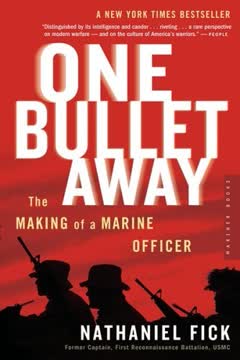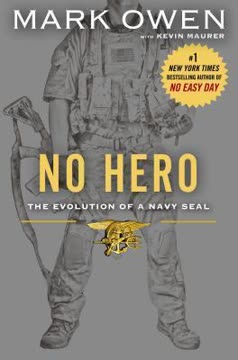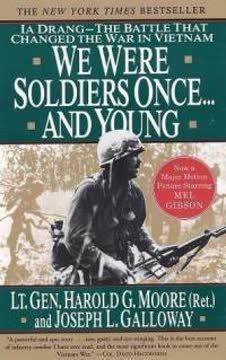Key Takeaways
1. The Unwavering Call to Serve: A Marine's Destiny
The Marine recruiter came out in his dress blues and said that most of us weren’t good enough to be in his Marine Corps. He didn’t promise us anything except we would be the best trained warriors in the world when the Marine Corps finished with us. I decided right then I wanted to serve with the best.
Early ambition. Brad Kasal, hailing from the small farming town of Afton, Iowa, harbored a singular ambition from a young age: to become a Marine. Unlike other recruiters who emphasized benefits and education, the Marine recruiter's challenge—that most weren't good enough—resonated deeply with Kasal's desire for excellence and to be part of an elite fighting force. This early decision shaped his entire adult life, driving him to research military history and prepare himself physically and mentally.
Physical preparation. Growing up, Kasal was known for his exceptional work ethic on his family's farm and his dedication to physical fitness. He excelled in sports like wrestling and football, constantly pushing his physical limits. This rigorous self-training proved invaluable during Marine Corps boot camp, where he distinguished himself and earned meritorious promotions, setting the stage for a career defined by physical prowess and leadership.
First steps. After graduating high school, Kasal immediately enlisted, enduring the transformative experience of boot camp. He was meritoriously promoted to Private First Class and then selected for infantry training, fulfilling his dream of becoming a "Grunt." His initial assignment to Weapons Company, 2nd Battalion, 1st Marine Regiment, marked the beginning of a long and distinguished career at the sharp end of America's military might.
2. Leading from the Front: The "Grunt" Ethos
Leadership is not about ego. It is about taking men into battle and keeping them alive.
The "Robo-Grunt." Brad Kasal embodied the Marine Corps' "Grunt" ethos, a term of respect for infantrymen who are first into combat and last out. Known as "Robo-Grunt" by his younger Marines, Kasal consistently led from the front, pushing himself harder than anyone else. His philosophy centered on direct, visible leadership, ensuring his men understood their mission and felt supported by his presence in the thick of the fight.
Unparalleled dedication. Kasal's commitment to the infantry was exceptional, spending over 18 years in the role, a rarity in a physically demanding branch. He constantly sought out challenging training, from Ranger School to Winter Mountain Leadership courses, not for accolades but to hone his skills and be a more effective leader. His relentless pursuit of excellence set a high standard for his troops, inspiring them to perform beyond their perceived limits.
Warrior's mindset. Kasal viewed combat as a "motherfucker"—unrelenting, unforgiving, and deadly—and believed Marines were trained to win by any legal means necessary. He instilled in his men the importance of discipline, aggression, and the understanding that their primary purpose was to "close with the enemy and kill them." This pragmatic, no-nonsense approach to warfare, combined with his personal bravery, earned him the deep respect and loyalty of every Marine under his command.
3. Adapting to a Shifting Battlefield: From Liberation to Insurgency
Our motto came from General Mattis... ‘No Better Friend, No Worse Enemy.’ My young Marines had to be trained—to be instructed—that we couldn’t go around indiscriminately killing people. They understood that and did what they were supposed to do. But there were people there who were trying to kill us at the same time.
OIF 1: A different war. Kasal's first deployment to Iraq in 2003 during Operation Iraqi Freedom 1 was marked by a sense of liberation, with Iraqis often welcoming Marines. The "Bridge Fights" at An Nasiriyah, though fierce, were against a conventional, albeit disorganized, army. Kasal observed the initial euphoria and believed in the mission to help the Iraqi people, a stark contrast to the later realities.
OIF 2: The rise of insurgency. By 2004, the nature of the conflict had drastically changed. Kasal's second deployment to al-Anbar province saw Marines facing a burgeoning insurgency characterized by:
- Improvised Explosive Devices (IEDs)
- Sniper attacks and ambushes
- Hit-and-run tactics
- Foreign fighters and radical jihadists
The mission shifted from conventional warfare to complex counter-insurgency, demanding a delicate balance between winning "hearts and minds" and lethal force.
The dilemma of restraint. General Mattis's "No Better Friend, No Worse Enemy" mandate became a double-edged sword. Marines were instructed to show restraint and build trust, even as insurgents exploited these rules by blending with civilians and launching attacks. This created immense frustration and resentment among the troops, who watched their comrades fall to enemies they couldn't always identify or immediately retaliate against, fueling a desire for decisive action.
4. Fallujah: A City Forged into a Fortress
Fallujah’s architectural makeup, coupled with its bloody history, made it well-suited to defending against a siege—even a modern, hi-tech siege conducted by the best-trained, best-equipped fighting force in the world.
A historical battleground. Fallujah, known as "the city of mosques," was an ancient city with a history of fierce resistance against invaders. Its dense urban environment, characterized by reinforced concrete buildings, thick-walled courtyards, and a maze of alleyways, provided ideal defensive positions for the insurgents. This made it a formidable challenge for any invading force, reminiscent of the brutal house-to-house fighting seen in Hue City during Vietnam.
Insurgent preparations. During a six-month "cease-fire" period, insurgents, including Abu Musab al Zarqawi's al Qaeda network, transformed Fallujah into a death trap. They:
- Stockpiled weapons and supplies in thousands of houses.
- Established bomb-making factories and torture chambers.
- Booby-trapped buildings and key entry points.
- Intimidated residents into supporting or not opposing their cause.
This meticulous preparation created an entrenched, fanatical opposition determined to fight to the death.
The opening gambit. The battle, codenamed Operation New Dawn (al-Fajr), began with a massive aerial bombardment to "shape the battlefield," followed by a ground assault. Kasal's battalion, the "Thundering Third," was tasked with securing the train station, a critical jump-off point. The initial days involved heavy artillery, air strikes, and the use of Army tanks to breach defenses, but the true test came when Marines dismounted to clear the city house by house, facing an enemy that preferred close-quarters combat.
5. The House of Hell: A Defining Act of Self-Sacrifice
In all honesty I thought I was going to bleed to death from severe wounds and lack of medical treatment anyway... So out of instinct—and love for the Marine next to me—I did the only thing any Marine would do if faced with the same situation: I protected my brother.
The ambush. On November 13, 2004, Kasal, supporting Kilo Company, found himself in the "House of Hell," a seemingly ordinary dwelling that was, in fact, a meticulously prepared insurgent stronghold. When Marines were pinned down inside, Kasal, ignoring his rank and personal safety, rushed in to assist. He eliminated one insurgent but was then severely wounded in the legs by an enemy firing from an elevated position, immobilizing him and Lance Corporal Alex Nicoll.
A selfless act. As grenades were thrown at their position, Kasal made a conscious decision to sacrifice himself for his fellow Marine. He rolled on top of Nicoll, shielding him from the blast with his own body. This act of profound selflessness resulted in Kasal sustaining additional shrapnel wounds across his back, buttocks, and legs, further exacerbating his already catastrophic injuries.
The rescue. Despite his severe wounds and immense pain, Kasal remained lucid and focused on protecting Nicoll and guiding the rescue efforts. Sergeant R.J. Mitchell, also wounded, bravely entered the room to provide aid, while Lieutenant Jesse Grapes and other Marines orchestrated a daring extraction under heavy fire. Kasal refused medical attention until Nicoll was treated, embodying the Marine Corps' "no man left behind" ethos. His iconic image, pistol in hand, being helped from the house, became a symbol of Marine courage.
6. Unbreakable Spirit: The Grueling Road to Recovery
You can break a Marine’s body but never his spirit.
Catastrophic injuries. Kasal's injuries were extensive: seven gunshot wounds and 44 shrapnel wounds, including a nearly severed right leg, perforated buttocks, and a shattered tibia. Doctors at Camp TQ and later Bethesda Naval Hospital initially feared amputation. His recovery involved over 20 surgeries, including a skin graft and the installation of a painful Ilizarov frame to reconstruct his leg, a device he would wear for months.
Defying predictions. Despite medical professionals advising amputation and stating he would never run again, Kasal refused to accept this prognosis. His fierce independence and warrior spirit drove him to endure excruciating pain and countless indignities. He insisted on performing basic tasks himself, even against doctor's orders, viewing every small act of self-reliance as a step towards regaining his life and proving the doubters wrong.
The long fight. Kasal's recovery was a 14-month odyssey of physical therapy, emotional struggle, and unwavering determination. He battled depression and fear of the unknown, but his resolve to return to duty never wavered. After 17 months, he walked without assistance, and at 18 months, he achieved his goal of running 50 feet. Less than two years after being wounded, he passed a Marine Corps physical fitness test, a testament to his indomitable will and a powerful example for other wounded warriors.
7. The Enduring Power of Brotherhood and Duty
My body may have been broken, but it was nothing compared to the pain I felt in my heart from not being with my Marines. I actually felt guilty lying there in the hospital.
Camaraderie as a lifeline. Throughout his ordeal, Kasal's deepest pain stemmed not from his physical wounds, but from being separated from his Marines. He felt a profound sense of guilt for not being with them in Fallujah and later, for not being there to welcome them home. This powerful bond of brotherhood, forged in combat, was a constant source of motivation for his recovery.
Leadership beyond the battlefield. Even from his hospital bed, Kasal continued to lead, visiting other wounded Marines, offering encouragement, and ensuring their well-being. His concern for his men was paramount, and he maintained contact with his unit in Iraq, eager for updates on their progress. This unwavering commitment to his role as a leader, even when severely incapacitated, highlights the deep sense of responsibility he felt towards his Corps.
A legacy of honor. Kasal's extraordinary heroism was recognized with the Navy Cross, the nation's second-highest award for valor. His story, captured in Lucian Read's iconic photograph, became a symbol of Marine courage and sacrifice. Despite his injuries, Kasal remains dedicated to the Marine Corps, hoping to return to operational forces and continue leading, embodying the timeless values of duty, honor, and unwavering commitment to his fellow Marines.
Last updated:
Review Summary
My Men Are My Heroes received mostly positive reviews, with readers praising the book's portrayal of Marine life, leadership, and combat experiences. Many found Kasal's story inspiring and appreciated the focus on his men. Some criticized the writing style as repetitive or lacking depth. Readers valued the detailed account of the Fallujah battle and Kasal's recovery. Several reviewers noted the book's importance in understanding the Marine mindset and the realities of war, despite its flaws in execution.
Similar Books
Download PDF
Download EPUB
.epub digital book format is ideal for reading ebooks on phones, tablets, and e-readers.








